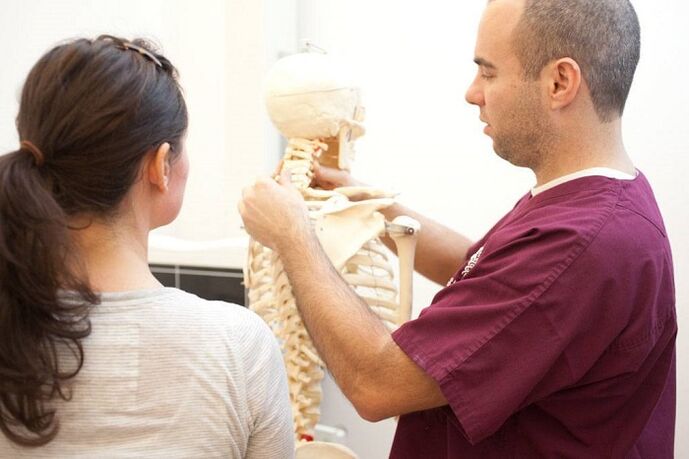Osteochondrosis of the cervical spine belongs to the category of long-term chronic diseases. In the process of disease development, the intervertebral space is destroyed, which, if left untreated, inevitably leads to the formation of a disc herniation. In the modern world, both the elderly and children suffer from osteochondrosis. At the same time, the healing process is delayed for months and even years, and does not always guarantee a positive result. Therefore, this problem should be approached with great seriousness, because the sooner a doctor can determine the presence of cervical osteochondrosis and prescribe treatment, the greater the chances that the patient will restore his health.

The disease in question has quite characteristic manifestations, so it will be difficult not to notice them. However, before considering information on how to determine cervical osteochondrosis, it is necessary to find out what its symptoms and factors are responsible for its occurrence.
Osteochondrosis is a chronic disease that causes the onset of degenerative processes within the connective cartilage tissue located between individual vertebrae. The progression of the disease disrupts the normal functioning of the body and can cause disability. At the same time, destructive processes cause inflammation that is transmitted to nerve fibers passing nearby. This development leads to spasms of the muscles, which are overstretched, trying to prevent the compression of blood vessels and nerve roots.
However, without external intervention the body can not cope with the disease and, as a result, reducing the gap between individual vertebrae, along with other consequences of osteochondrosis, will lead to significant difficulties in blood circulation, and the human brain will not receive oxygen and important nutrientsin the required quantities. Of course, this will immediately affect the patient’s self-awareness, so osteochondrosis can be determined by a number of characteristic symptoms.
Main symptoms
The most common symptoms are:
- constant neck and head pain;
- regular bouts of nausea, sometimes vomiting;
- strong and sudden changes in blood pressure;
- dizziness, fainting.
As you can see, the symptoms are quite specific and it is impossible not to notice them, so it will not be difficult to determine osteochondrosis in the neck area. However, only an experienced neurologist should make a diagnosis, because this disease affects the work of many functions and during the examination it is necessary to compile an accurate picture of what is happening in order to prescribe the most effective course of treatment.

To determine the nature of the course of osteochondrosis of the cervical spine, the patient is sent for X-ray and computed tomography. In some cases, an ultrasound examination may be prescribed. As a rule, this occurs with complaints of chest pain on the background of absent cardiac pathologies.
The manifestation of heart pain in patients with osteochondrosis in the neck indicates the active spread of the disease along the spinal column. Such a symptom is rare, so the neurologist will definitely first send the patient for an examination to a cardiologist, who must determine heart problems or confirm their absence. If the work of the cardiac system takes place without disturbances, there is no reason to worry, because osteochondrosis alone in no way affects the activity of such an important organ as the heart.
The above symptoms appear from the first weeks of the onset of the disease. The only exceptions are dizziness and nausea, because these unpleasant sensations are found in patients in 2-3 stages of disease development.
There are a total of three stages of disease development, the third of which manifests itself in the most insidious way. If you do not treat osteochondrosis of the cervical spine, its transition to a severe form will lead to disruption of the normal functioning of many vital systems of the human body.
Prerequisites for the occurrence of osteochondrosis
There are many factors that are considered manifestations of osteochondrosis of the spine in the neck. However, the main one is improper posture of the spine. That is why it is extremely important to create a kind of habit for maintaining the correct position of the body during work and rest from childhood.
Another very significant factor is called a sedentary lifestyle. A modern person usually complains about the lack of time for sports, but at the same time he can spend a lot of time recklessly surfing the waves of the Internet, empty communication on social networks or computer games.

Most people report great benefits of simple morning exercises from childhood. Yet few modern people do this, although simple physical exercises in the morning can stimulate blood circulation, experience real zest and help create a good mood for the whole day. In addition, morning exercises will keep your joints healthy and mobile for many years to come.
The last serious factor that causes osteochondrosis of the spine in the neck area, as well as many other problems, is a lack of vitamins. Usually the human body lacks vitamins in winter and early spring, so you should eat as many raw vegetables and fruits as possible during these periods or buy vitamin complexes that are sold in any pharmacy. Attention should be paid to other microelements important for the body. By the way, many people mistakenly believe that osteochondrosis occurs due to calcium deficiency. This is not the case, although calcium should be used in the treatment of the disease, as it promotes rapid healing of the cartilaginous tissue.
The main stages of osteochondrosis
- First.In the initial stage, dull pain appears which quickly disappears if the person keeps the body at rest for some time. Also, the patient may notice spikes in blood pressure, which is the first sign of oxygen starvation of the brain.
- Seconds.The next stage already significantly obscures the usual way of life, because the neck pain syndrome becomes quite strong and does not always disappear even after taking analgesics. As a result, a person is extremely irritable, which negatively affects the attitude of others towards him. In addition, there is a constant feeling of fatigue, systemic headaches appear.
- Third.The last stage is considered the most dangerous. The patient develops unbearable pain in the neck and head, with which even strong painkillers cannot always cope. Dizziness, nausea, limited movement, etc. also appear.
As you can see, osteochondrosis has quite pronounced symptoms, however, in the initial phase, many people simply ignore the signs of an impending catastrophe. It is extremely important to be careful and recognize the disease in time at the first weak manifestations.
As a rule, patients of neuropathology are people whose osteochondrosis has already passed into the second phase of its development. This complicates the healing process, as it is possible to effectively fight the disease only in the initial stage.

Remember that osteochondrosis is one of the most serious back diseases. This can have a negative impact on the operation of several vital systems at once. If you do not seek professional help in time, as a result you can start a disease that will lead to the formation of a spinal hernia, with only surgical intervention to correct the situation.
The recovery process in osteochondrosis is long delayed and can be successful only with strict adherence to all medical prescriptions. Under no circumstances should you self-diagnose and prescribe treatment, as you may further aggravate the situation.
Many believe that osteochondrosis is the last sentence and that it is impossible to fully recover from it. In fact, this is not the case at all if the disease has not passed into the final stage of development. In other cases, the situation can be corrected, but for this you need to focus on long and hard work, and in addition you will need to change your lifestyle, making sports and outdoor activities an integral part.

























